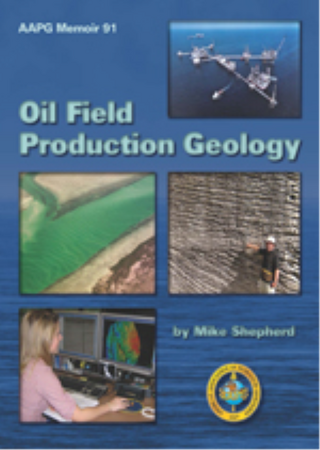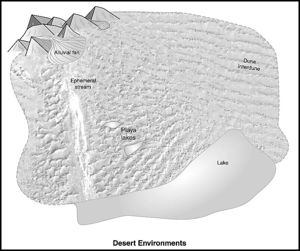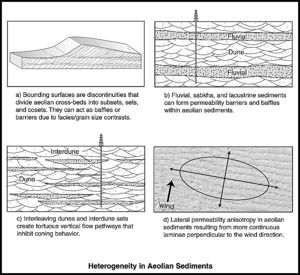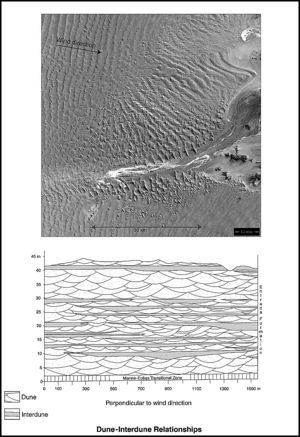Difference between revisions of "Eolian reservoirs"
m (Molyneux moved page Eolian reservoir to Eolian reservoirs) |
|
(No difference)
| |
Revision as of 20:59, 29 July 2015
This page is under development
| Oil Field Production Geology | |

| |
| Series | Memoirs |
|---|---|
| Part | The Production Geologist and the Reservoir |
| Chapter | Eolian reservoirs |
| Author | Mike Shepherd |
| Link | Web page |
| PDF file (requires access) | |
| Store | AAPG Store |
Eolian sediments comprise desert sediments and coastal sand dunes, much of which are wind deposited. They can form thick and laterally extensive sandstone reservoirs. Eolian sandstone reservoirs are commonly found in two time intervals in the geological record, the early Paleozoic and between the Permian and the Early Jurassic.[1]
Eolian lithofacies associations
Eolian lithofacies associations include dune, interdune, fluvial, and sabkha environments (Figure 1). Dunes form where large volumes of dry sand are blown across the landscape. Lying between the dunes are the interdune areas, which are flat-lying belts or depressions. These areas may be subjected to either erosion or deposition. In wetter conditions, alluvial fans may extend outwards from upland areas, and fluvial sediments can be deposited by ephemeral streams. Large damp to wet areas between the dunes may dry out to form flat-lying evaporitic crusts called sabkhas. Playa lakes are desert lakes that episodically dry out.
Several different dune types are found in deserts. They can form as crescentic dunes (including barchan dunes), as long linear dunes, or as star dunes with crest lines radiating from one or two central peaks. Different dune types may be superimposed to form complex dunes, whereas the same type of dune is superimposed to form compound dunes. The term draa has been used to refer to large compound or complex dunes.[2]
In deserts, dune sediments aggrade laterally and vertically as large-scale sand blankets. These may be very thick (more than 300 m [1000 ft]), and cover hundreds of square kilometers.[3] Internally, dunes comprise thick, cross-bedded intervals of well-rounded, well-sorted sandstones. They are normally the most productive lithofacies in eolian reservoir systems. Flatter-lying eolian sand sheets may be found along the margins of dune systems.[4]
Interdune and fluvial sediments generally show poorer reservoir characteristics by comparison to dune lithofacies. They are poorly sorted and are more likely to contain evaporite cements. Intercalated fine-grained sand and silt laminations together with diagenetic cementation tend to produce reservoir intervals with very poor vertical permeability. Nagtegaal[5] used multivariate analysis to determine the factors controlling the porosity of eolian sediments from the Permian of the southern North Sea. He found that the main control on porosity is grain sorting, which varies from well sorted in dune sandstones to less well sorted in the other associated sediments. The relationship between original sedimentary texture and porosity has survived even after extensive diagenesis. The very poor permeability characteristics of interdune sediments are commonly reported. Lindquist[6] found a contrast in permeability of four to five orders of magnitude between interdune and dune deposits in the Nugget Sandstone of southwestern Wyoming.
Geometry
Eolian sediments form layer-cake to jigsaw-puzzle geometries. Dune sand bodies may intercalate with or pinch out into poorer quality sabkha and fluvial facies associations. Eolian environments tend to occur on a large scale and dune sandstones can be greater in length than typical well spacings. Weber[7] described outcrops of eolian sandstone in the Permian De Chelly Sandstone in northern Arizona. The average thickness of cross-bed sets is about 6 m (20 ft). The width-to-thickness ratio is estimated as between 50:1 and 100:1. The length-to-thickness ratio is estimated as 200 to 1.
Heterogeneity of eolian sandstones
It is difficult to make generalizations about the effect of heterogeneity on hydrocarbon recovery from eolian sandstones as recovery factors seem to vary enormously worldwide. It is possible that eolian sandstones are much better suited as gas than oil reservoirs. Some of the Western European Permian desert sandstone gas reservoirs show very high recoveries; a 91% recovery factor is quoted for the Leman gas field for instance.[8] By comparison, the viscous oil reservoirs of the Pennsylvanian to Permian Tensleep Sandstone of Wyoming and Montana show low recoveries by primary production. In the Little Buffalo Basin field of Wyoming, well spacing has been reduced successively from 40- to 20- to 10- to 5-ac spacing, in some cases without interwell interference.[9][10]
Ciftci et al.[11] attributed the poor recovery in the Tensleep Sandstone to low permeability baffles and barriers along bounding surfaces within the eolian dune sets. Bounding surfaces are subhorizontal to inclined discontinuities that divide eolian cross-beds into subsets, sets, and cosets (Figure 2a). These form as a result of dune migration at the smaller scale and from regional discontinuities at the larger scale. Bounding surfaces have a tendency to act as baffles or barriers as a result of facies and grain size contrasts across them.[12] Perhaps the considerable difference in recoveries between the eolian reservoirs of Northwestern Europe and the United States is a function of how bounding surfaces influence fluid flow in each area. These features may provide less of an impedance to the flow of highly mobile gas in the Northwestern Europe gas fields than they do for the viscous oil found in the Tensleep Sandstone of Wyoming and Montana.
One other factor may contribute to poorer oil than gas recoveries in eolian sediments. In oil fields, a significant volume of capillary-trapped oil can result from the waterflooding of dune-bedded sandstones. Huang et al.[13] showed that between 30 and 55% of the oil was trapped in a coreflood experiment on cross-laminated eolian sandstone under conditions of low-rate flooding.
Vertical permeability barriers in eolian sandstones
Fluvial and sabkha sediments deposited in interdune areas can be permeability barriers and baffles within eolian sediments (Figure 2b). These may either be confined to interdune areas and of limited extent or they can be laterally extensive on a basin scale.
Baffles of limited areal extent in interdune areas are described by Shebi[12] from the Tensleep Sandstone of the Bighorn Basin in northwestern Wyoming and southwestern Montana. These are thin, discrete intervals of dolomite and anhydrite, about 0.15–0.7 m (0.5–2 ft) thick and with lateral dimensions on the scale of a few meters to tens of meters. The dolomite and anhydrite intervals are interpreted as sabkha deposits, which formed in wet interdune areas and playa lakes.
Studies in the western United States have shown that some sabkha units can be traced for several kilometers within the Mesozoic eolian sediments.[14] Cyclic climatic conditions resulted in alternating dune sandstone and widespread sheet-like fluvial deposits in the Jurassic Kayenta-Navajo Formations of northeastern Arizona.[15]
The degree of layering within an eolian reservoir can therefore range from moderate to intense.[16] Probably a major control on this is as to whether dry desert or wet desert conditions prevail, the latter associated with extensive fluvial, sabkha, and lacustrine interbeds.
Vertical permeability barriers can also be formed by diagenetic cements. Chandler et al.[17] noted that meteoric water can seep along bounding surfaces with the preferential formation of carbonate and silicate cements. Where the lower part of a dune is below a water table, early cementation may form a permeability barrier.[18]
Lateral permeability anisotropy within dune sandstones
Horizontal and vertical permeability can be highly variable at the laminar scale in dune sandstones (e.g., Prosser and Maskall[19]). This results from the configuration of the three basic strata types in dune sandstones: wind-ripple, grain-flow, and grain-fall deposits.[20]
Sand grains migrate over dunes, forming rippled surfaces. The grains pack together relatively closely in wind-rippled strata, and the porosity is lower in these units. Inverse grading is common with low-permeability pin-stripe laminae reducing the vertical permeability. Chandler et al.[17] found in the Page Sandstone of Arizona that the grain size ratio from the coarse-grained to the fine-grained parts of each wind-rippled strata averages 3:1 and can be as much as 7:1. The permeability ratio between the coarse and fine laminae gives an average value of 11:1 with a maximum value of 75:1.
When the wind-blown sediments reach the brinkline of the dune, the wind speed drops and the grains fall onto the leeward dune slip face, coming to rest as grain-fall deposits. These form parallel-laminated, slightly tapering strata. Grain size can vary between the individual strata.
On steep surfaces, avalanches may occur, forming grain-flow deposits. These develop as cone- or tongue-shaped geometries at the base of the slipface. Grain-flow cross strata are thicker than other eolian strata, up to a maximum of 2–5 cm (0.7–1.9 in.) thick. They are internally structureless or show subtle grading. The grain packing of grain-flow deposits is relatively loose as a result of the very rapid deposition of the grains. Thus, grain-flow deposits tend to be more porous and permeable compared to the other strata types.
The contrast in grain size and sorting between the individual sand streaks in dune beds results in large variations in permeability. Permeability differences can be exacerbated by early diagenesis. Fine-grained laminae can potentially draw in cementing solutes by capillary action.
All three strata types may be found on dune foresets. By contrast, wind-ripple lamination dominates the interdune sediments. These are typically poorly sorted and finely laminated. Interdune sediments probably create an interleaving network of permeability baffles, which serve to create tortuous flow pathways upward through stacked dune reservoirs (Figure 2c, Figure 3). They can act to inhibit coning in thick dune sandstone reservoirs.[7]
Eolian dune sets show strong lateral permeability anisotropy within the reservoir. Reservoir fluids flowing across the wind-flow direction are impeded by pin-stripe lamination of fine-grained material along the dune cross sets. By contrast, the individual layers and laminae are much more continuous along the depositional strike trend of the dune system, perpendicular to the wind flow direction (Figure 2d).[7] Krystinik[16] stated that, in most eolian reservoirs, the anisotropy permeability ratio is between 4:1 and 25:1, although the overall range may be approximately 1: 1 and up to 200:1 locally. He recommends that horizontal core plugs should be taken both along and perpendicular to the wind-flow direction in order to assess the lateral permeability anisotropy in dune sandstones. Follows[22] described how a horizontal well was planned to be drilled along depositional dip in the Auk oil field in the UK North Sea. The intention was to connect up the highest number of grain-flow sets between bounding laminae so as to maximize production.
See also
References
- ↑ Cite error: Invalid
<ref>tag; no text was provided for refs namedNorth_1985 - ↑ Cite error: Invalid
<ref>tag; no text was provided for refs namedKocurek_1996 - ↑ Cite error: Invalid
<ref>tag; no text was provided for refs namedRichardsonetal_1988a - ↑ Cite error: Invalid
<ref>tag; no text was provided for refs namedKocurekandnielson_1986 - ↑ Cite error: Invalid
<ref>tag; no text was provided for refs namedNagtegaal_1979 - ↑ Cite error: Invalid
<ref>tag; no text was provided for refs namedLindquist_1983 - ↑ 7.0 7.1 7.2 Cite error: Invalid
<ref>tag; no text was provided for refs namedWeber_1987 - ↑ Cite error: Invalid
<ref>tag; no text was provided for refs namedHillier_2003 - ↑ Cite error: Invalid
<ref>tag; no text was provided for refs namedMccaleb_1979 - ↑ Cite error: Invalid
<ref>tag; no text was provided for refs namedAhlbrandtandfryberger_1982 - ↑ Cite error: Invalid
<ref>tag; no text was provided for refs namedCiftcietal_2004 - ↑ 12.0 12.1 Cite error: Invalid
<ref>tag; no text was provided for refs namedShebi_1995 - ↑ Cite error: Invalid
<ref>tag; no text was provided for refs namedHuangetal_1995 - ↑ Cite error: Invalid
<ref>tag; no text was provided for refs namedCrabaughandkocurek_1993 - ↑ Cite error: Invalid
<ref>tag; no text was provided for refs namedHerries_1993 - ↑ 16.0 16.1 Cite error: Invalid
<ref>tag; no text was provided for refs namedKrystinik_1990 - ↑ 17.0 17.1 Cite error: Invalid
<ref>tag; no text was provided for refs namedChandleretal_1989 - ↑ Cite error: Invalid
<ref>tag; no text was provided for refs namedNorthandprosser_1993 - ↑ Cite error: Invalid
<ref>tag; no text was provided for refs namedProsserandmaskall_1993 - ↑ Cite error: Invalid
<ref>tag; no text was provided for refs namedHunter_1977 - ↑ Cite error: Invalid
<ref>tag; no text was provided for refs namedKocurek_1981 - ↑ Cite error: Invalid
<ref>tag; no text was provided for refs namedFollows_1997


